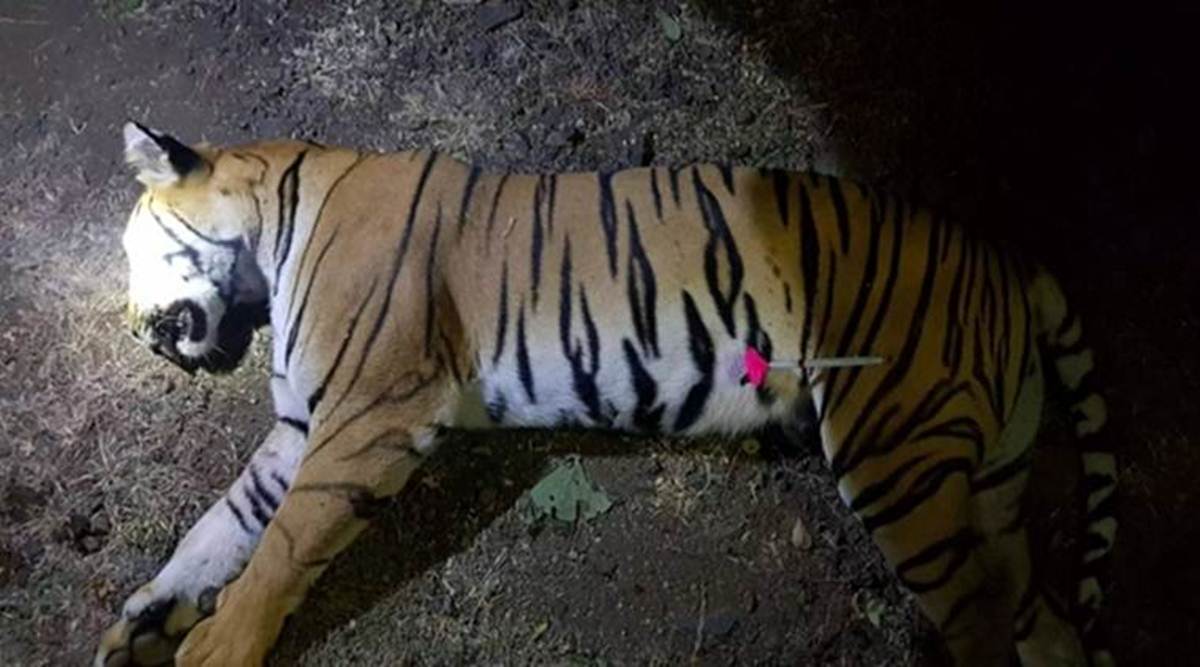No success in tranquilisation efforts after nine-month pursuit, capture order renewed fourth time since January.
The “problem” tiger of Rajura in Chandrapur district seems to have claimed its eighth victim on Monday, raising urgency over the need to catch it. Forest officials said the tiger, named RT1, killed a senior citizen from Khambada village in Rajura tehsil.
The deceased was identified as Maroti Pendam. “Pendam had gone to the forest when the tiger pounced upon him,” said Deputy Conservator of Forest Arvind Mundhe.
Mundhe added, “We found pug marks suggesting it could be the same tiger. We have taken swabs and sent them for forensic testing.”
Mundhe also said the tiger had largely devoured Pendam’s body during the intervening night of Monday and Tuesday.
This is the second human death in reported big cat attacks within a week, after the first was reported on October 1 in which a leopard killed an 11-year-old boy in Brahmapuri tehsil of the same district.
The tiger, before this, had killed a person on September 26 in Virur village. Its first victim, reported on January 18 last year, was also from Khambada village.
This tiger has attacked 11 people so far, leading to eight deaths and three injuries. This is the highest number of human casualties caused by any tiger in Maharashtra.
The previous record was of five deaths caused by T1 (Avni) from Pandharkawada in Yavatmal district. The tigress with two cubs was controversially shot dead on November 2, 2018, after three months of intensive pursuit.
Now, RT1’s case is proving to be a similar challenge for the forest department, as it has been unable to tranquilise the tiger despite nine-month-long efforts. Four teams have been trying to corner the six-year-old, wandering over a vast area spread over three forest ranges of Virur, Rajura and Kothari.
Principal Chief Conservator of Forest (PCCF, Wildlife) Nitin Kakodka, last week renewed its capture order for the fourth time since January.
Asked if RT1 evading capture could make a case for shooting it, Kakodkar said, “We will have to examine all cases carefully before thinking of any such terminal remedy. We will try to adopt some other strategy to catch it.”
The task, however, is proving to be difficult for the tracking teams. The tiger kills its bait but only during the night, when tranquilisation is not allowed.
Mundhe said, “Two days ago, we came close to catching it. Our men were waiting in a cage near a bait. He came and killed the bait and even as we fired a dart, it ran away within seconds.”
While it only shows how difficult it is to catch the tiger, the forest department can take solace in the fact that people from the affected area in Chandrapur are not yet showing the outrage they had in Avni’s case.
Mundhe said people had practised restraint after the incidents. “But despite repeated warnings, they are still venturing into the forest,” he said.
The record, however, shows that at least three attacks by RT1 – two of them fatal – were in agricultural farms. The tiger had also partly eaten the bodies of its victims.
Two leading wildlife activists feel the option of elimination could be exercised if capture is not possible. Nitin Desai, central India director, Wildlife Protection Society of India, said, “This tiger has attacked 11 people, killing eight of them. It appears that it has not only lost its fear of humans, but is attacking and eating victims.
If tranquilising it is impossible, it should immediately be put down in the larger interest of tiger conservation. The behaviour of one rogue tiger endangers all wild tigers. Even if caught alive, it would serve no purpose of conservation.”
Desai added, “The decision to kill Avni was difficult as she had two cubs. That’s not the factor in this case.”
Kishor Rithe, member of State Wildlife Board, said, “We must try and safely capture the animal. If forest officers feel it is difficult to capture it due to its unique behaviour or field situation, they should plan for elimination. However, it should be strictly done by expert forest officers and not by trigger-happy hunters.”
? The Indian Express is now on Telegram. Click here to join our channel (@indianexpress) and stay updated with the latest headlines
For all the latest India News, download Indian Express App.
Source: Read Full Article


